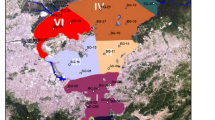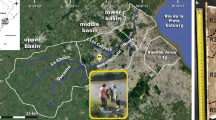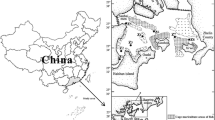Abstract
Acid volatile sulfide (AVS) has been regarded as an important factor controlling metal bioavailability in anoxic sediments, but its effect on metal accumulation under natural conditions is poorly understood. Here, a field study of the influence of AVS on metal accumulation by Limnodrilus sp. in a heavily polluted river is provided. Most of the study area was subject to anaerobic and strongly reducing conditions, and the concentration of trace metals in surface sediments was high, as were the concentration of AVS and simultaneously extracted metals (SEM; average AVS = 20.3 μmol g−1, average ∑SEM5 = 9.42 μmol g−1; ∑SEM5 refers to the sum of SEMCd, SEMCu, SEMPb, SEMNi, and SEMZn). Only a few species and small quantities of benthic invertebrates were found, and Limnodrilus sp. was dominant. There was no correlation between trace metal accumulation and (SEM-AVS), and in stations where (SEM-AVS) <0, the absolute value of bioaccumulation was high (average ∑BIO5 = 4.07 μmol g−1; ∑BIO5 refers to the sum of BIOCd, BIOCu, BIOPb, BIONi, and BIOZn), indicating that there was no relationship between (SEM–AVS) and metal accumulation in Limnodrilus sp. This was likely because Limnodrilus sp. ingest sediment particles as their main food source, so pore water metals play a minor role in their bioaccumulation (BIO) of materials. However, ∑BIO5 was significantly correlated with ∑SEM5 (r = 0.795, p < 0.01), revealing that the large number of sulfide-bound metals (SEM) in sediments may play an important role in metal accumulation in Limnodrilus sp., which can assimilate sulfide-associated metals by the help of the digestive fluids in the digestive systems.







Similar content being viewed by others
References
Allen, H. E., Fu, G., & Deng, B. (1993). Analysis of acid-volatile sulfide (AVS) and simultaneously extracted metals (SEM) for the estimation of potential toxicity in aquatic sediment. Environmental Toxicology and Chemistry, 12, 1441–1453.
Ankley, G. T. (1996). Evaluation of metal/acid-volatile sulfide relationships in the prediction of metal bioaccumulation by benthic macroinvertebrates. Environmental Toxicology and Chemistry, 15, 2138–2146.
Berner, R. A. (1964). Distribution and diagenesis of sulfur in the sediments from the Gulf of California. Marine Geology, 1, 117–140.
Berry, W. J., Boothman, W. S., Serbst, J. R., & Edwards, P. A. (2004). Predicting the toxicity of chromium in sediments. Environmental Toxicology and Chemistry 23, 2981–2992.
Berry, W. J., Hansen, D. J., Mahony, J. D., Robson, D. L., Di Toro, D. M., Shipley, B. P., et al. (1996). Predicting the toxicity of metal-spiked laboratory sediments using acid-volatile sulfide and interstitial water normalizations. Environmental Toxicology and Chemistry, 15, 2067–2079.
Borgmann, U., Neron, R., & Norwood, W. P. (2001). Quantification of bioavailable nickel in sediments and toxic thresholds to Hyalella azteca. Environmental Pollution, 111, 189–198.
Burton, G. A., Green, A., Baudo, R., Forbes, V., Nguyen, L. T. H., Janssen, C. R., et al. (2007). Characterizing sediment acid volatile sulfide concentrations in European streams. Environmental Toxicology and Chemistry, 26, 1–12.
Camusso, M., Polesello, S., Valsecchi, S., & Vignati, D. A. L. (2012). Importance of dietary uptake of trace elements in the benthic deposit-feeding Lumbriculus variegatus. TrAc -Trends in Analytical chemistry, 36, 103–112.
Casas, A., & Crecelius, E. (1994). Relationship between acid volatile sulfide and the toxicity of zinc, lead and copper in marine sediments. Environmental Toxicology and Chemistry, 13, 529–536.
CeDAMar (Census of the Diversity of Abyssal Marine Life)(2006). Methodologies for sampling benthos of deepsea basins and abyssal plains. http://www.caml.aq/benthos/documents/Benthos-Deep-Sampling.pdf. February 2006.
Cevik, F., Goksu, M. Z. L., Derici, O. B., & Findik, Ö. (2009). An assessment of metal pollution in surface sediments of Seyhan dam by using enrichment factor, geoaccumulation index and statistical analyse. Environmental Monitoring and Assessment, 152, 309–317.
De Jonge, M., Dreesen, F., De Paepe, J., Blust, R., & Bervoets, L. (2009). Do acid volatile sulfides (AVS) influence the accumulation of sediment-bound metals to benthic invertebrates under natural field conditions. Environmental Science and Technology, 43, 4510–4516.
De Jonge, M., Blust, R., & Bervoets, L. (2010). The relation between Acid Volatile Sulfides (AVS) and metal accumulation in aquatic invertebrates: implications of feeding behavior and ecology. Environmental Pollution, 158, 1381–1391.
De Jonge, M., Eyckmans, M., Blust, R., & Bervoets, L. (2011). Are accumulated sulfide-bound metals metabolically available in the benthic oligochaete Tubifex tubifex? Environmental Science and Technology, 45, 3131–3137.
De Jonge, M., Belpaire, C., Geeraerts, C., De Cooman, W., Blust, R., & Bervoets, L. (2012). Ecological impact assessment of sediment remediation in a metal-contaminated lowland river using translocated zebra mussels and resident macroinvertebrates. Environmental Pollution, 171, 99–108.
Di Toro, D. M., Mahony, J. D., Hansen, D. J., Scott, K. J., Hicks, M. B., & Redmond, M. S. (1990). Toxicity of cadmium in sediments: the role of acid volatile sulfide. Environmental Toxicology and Chemistry, 9, 1487–1502.
Di Toro, D. M., Mc Grath, J. A., Hansen, D. J., Berry, W. J., Paquin, P. R., Mathew, R., et al. (2005). Predicting sediment toxicity using a sediment biotic ligand model: methodology and initial application. Environmental Toxicology and Chemistry, 24, 2410–2427.
Garcia, C. A. B., Passos, E. A., & Alves, J. P. H. (2011). Assessment of trace metals pollution in estuarine sediments using SEM-AVS and ERM–ERL predictions. Environmental Monitoring and Assessment, 181, 385–397.
Grabowski, L. A., Houpis, J. L. J., Woods, W. I., & Johnson, K. (2001). Seasonal bioavailability of sediment-associated heavy metals along the Mississippi river floodpain. Chemosphere, 45, 643–651.
Griscom, S. B., Fisher, N. S., Aller, R. C., & Lee, B. G. (2002). Effects of gut chemistry in marine bivalves on the assimilation of metals from ingested sediment particles. Journal of Marine Research, 60, 101–120.
Hare, L., Carignan, R., & Huerta-Diaz, M. A. (1994). A field study of metal toxicity and accumulation by benthic invertebrates; implications for the acid-volatile sulfide (AVS) model. Limnology and Oceanography, 39, 1653–1668.
Huan, Z., & Wang, W. X. (2009). Inorganic mercury binding with different sulfur species in anoxic sediments and their gut juice extractions. Environmental Toxicology and Chemistry, 28, 1851–1857.
IESSYSU. (2006). The environmental impact assessment of dredging and sediment disposal engineering in Foshan Waterway. Guangzhou: The Institute of Environmental Science of Sun Yat-sen University.
Ingersoll, C. G., Haverland, P. S., Brunson, E. L., Canfield, T. J., Dwyer, F. J., Henke, C. E., et al. (1996). Calculation and evaluation of sediment effect concentrations for the amphipod Hyalella azteca and the midge Chironomus riparius. Journal of Great Lakes Research, 22, 602–623.
Lee, B. G., Griscom, S. B., Lee, J. S., Choi, H. J., Koh, C. H., Luoma, S. N., et al. (2000). Influences of dietary uptake and reactive sulfides on metal bioavailability from aquatic sediments. Science, 287, 282–284.
Lee, J. S., Lee, B. G., Yoo, H., Koh, C. H., & Luoma, S. N. (2001). Influence of reactive sulfide (AVS) and supplementary food on Ag, Cd and Zn bioaccumulation in the marine polychaete Neanthes arenaceodentata. Marine Ecology-Progress Series, 216, 129–140.
Li, F., Wen, Y. M., & Zhu, P. T. (2008). Bioavailability and toxicity of heavy metals in a heavily polluted river, in PRD, China. Bulletin of Environmental Contamination and Toxicology, 81, 90–94.
Li, F., Wen, Y. M., Song, W. W., & Song, M. W. (2009). Assessment of heavy metals pollution in sediments of Foshan Waterway with geoaccumulation index. In S. C. Li, Y. J. Wang, F. X. Cao, P. Huang, & Y. Zhang (Eds.), Progress in Environmental Science and Technology (Vol. II, pp. 1306–1310). USA: Science Press USA Inc.
Liu, J. C., Yan, C. L., Macnair, M. R., Hu, J., & Li, Y. H. (2007). Vertical distribution of acid-volatile sulfide and simultaneously extracted metals in mangrove sediments from the Jiulong River Estuary, Fujian, China. Environmental Science and Pollution Research, 14, 345–349.
MacDonald, D. D., Ingersoll, G., & Berger, T. A. (2000). Development and evaluation of consensus-based sediment quality guidelines for freshwater ecosystems. Archives of Environmental Contamination and Toxicology, 39, 20–31.
Morse, J. W., & Rickard, D. (2004). Chemical dynamics of sedimentary acid volatile sulfide. Environmental Science and Technology, 38, 131–136.
Mount, D. R., Dawson, T. D., & Burkhard, L. P. (1999). Implication of gut purging for tissue residues determined in bioaccumulation testing of sediment with Lumbriculus variegates. Environmental Toxicology and Chemistry, 18, 1244–1249.
Nguyen, L. T. H., Burton, G. A., Jr., Schlekat, C. E., & Janssen, C. R. (2011). Field measurement of nickel sediment toxicity: role of acid volatile sulfide. Environmental Toxicology and Chemistry, 30(1), 162–172.
Qi, S., & Huang, W. (1993). The benthic macroinvertebrate community relating to the water quality in lower Zhujiang (Pearl River). Acta Scientiae Circumstantiae, 13, 80–86 (in Chinese).
Reinhold-Dudok van Heel, H. C., & Den Besten, P. J. (1999). The relation between macroinvertebrate assemblages in the Rhine-Meuse Delta (The Netherlands) and sediment quality. Aquatic Ecosystem Health Management, 2, 19–38.
Rosenberg, D.M., Davies, I.J., Cobb, D.G., Wiens, A.P. (1997). Ecological monitoring and assessment network (EMAN) protocols for measuring biodiversity: benthic macro invertebrates in fresh waters. Dept. of Fisheries & Oceans, Freshwater Institute, Winnipeg, Manitoba. 53, Appendices.
USEPA. (1996a). Method 3050B: Acid digestion of sediments sludge and soils. Washington DC: U.S. Environmental Protection Agency.
USEPA (1996a). Assessment of sediment in the Indiana Harbor area of concern. EPA 905-R96-009, Great Lakes National Program Office, Region V, Chicago, IL.
USEPA. (1998). EPA’s contaminated sediment management strategy. Washington DC: U.S. Environmental Protection Agency.
USEPA. (2000). EPA600/R-99/064, methods for measuring the toxicity and bioaccumulation of sediment-associated contaminants with freshwater. Washington DC: U.S. Environmental Protection Agency.
USEPA. (2005). Procedures for the derivation of equilibrium partitioning sediment benchmarks (ESBs) for the protection of benthic organisms: metal mixtures (cadmium, copper, lead, nickel, silver and zinc). Washington DC: U.S. Environmental Protection Agency.
van Griethuysen, C., van Baren, J., Peeters, E. T. H. M., & Koelmans, A. A. (2004). Trace metal availability and effects on benthic community structure in floodplain lakes. Environmental Toxicology and Chemistry, 23, 668–681.
Wang, C. F., Fang, Z. Q., Zheng, S. D., & Jiang, Y. Y. (2003). Concentrations and distribution of heavy metals in sediments and benthic organisms from sewage stream in Guangzhou City. Journal of Safety and Environment, 3, 40–43 (in Chinese).
Yin, H. B., Deng, J. C., Shao, S. G., Gao, F., Gao, J. F., & Fan, C. X. (2011). Distribution characteristics and toxicity assessment of heavy metals in the sediments of Lake Chaohu, China. Environmental Monitoring and Assessment, 179, 431–442.
Yoo, H., Lee, J. S., Lee, B. G., Lee, I. T., Schlekat, C. E., Koh, C. H., et al. (2004). Uptake pathway for Ag bioaccumulation in three benthic invertebrates exposed to contaminated sediments. Marine Ecology-Progress Series, 270, 141–152.
Yu, K. C., Tsai, L. J., Chen, S. H., & Ho, S. T. (2001). Chemical binding of heavy metals in anoxic river sediments. Water Research, 35, 4086–4094.
Acknowledgments
We thank Ping-ting Zhu, Peng-jie Hu, Guang-hui Yu, Xiao-jin Zou, Yuan Qiu, and Jian-ping Liang for collecting the samples and for technical support. This work was partly founded by the National Natural Science Foundation of China (no. 41001341), the Nature Science Foundation of Guangdong Province, China (no. 9151401501000015), and the National Higher-Education Institution General Research and Development Project (2012ZM0082).
Author information
Authors and Affiliations
Corresponding author
Rights and permissions
About this article
Cite this article
Li, F., Zeng, Xy., Yu, Yj. et al. A field study of the relationship between sulfide-bound metals and bioaccumulation by Limnodrilus sp. in a heavily polluted river. Environ Monit Assess 186, 4935–4946 (2014). https://doi.org/10.1007/s10661-014-3749-y
Received:
Accepted:
Published:
Issue Date:
DOI: https://doi.org/10.1007/s10661-014-3749-y




